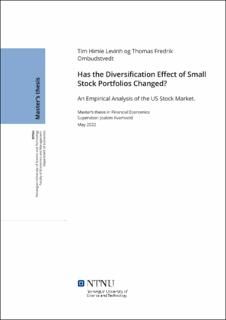Has the Diversification Effect of Small Stock Portfolios Changed?
Master thesis
Permanent lenke
https://hdl.handle.net/11250/3005942Utgivelsesdato
2022Metadata
Vis full innførselSamlinger
Sammendrag
I denne avhandlingen undersøker vi utviklingen til risikokomponentene til mindre porteføljer bestående av 1 til 30 aksjer og deres risikonivå. Når vi analyserer simulerte porteføljer de siste fire tiårene finner vi at diversifiseringsgevinsten av å legge til aksjer i mindre porteføljer har vært stabil. Til tross for at 8 til 10 aksjer holder for å fjerne mesteparten av det idiosynkratiske risikoen i porteføljer, har mindre porteføljer generelt lav avkastning. Vi bruker også en disaggregert modell og parametriske modeller for å studere den idiosynkratiske volatiliteten og sambevegelsen til avkastningen til aksjene listet på NYSE fra 1980 til 2021. Vi identifiserer et regime bytte hvor den gjennomsnittlige idiosynkratiske volatiliteten til aksjer har skiftet til et lav-volatilitets regime fra slutten av 90-tallet. I kontrast skiftet sambevegelsen til aksjene til et høy-korrelasjonsregime fra 2000 tallet. Netto effekten av regimeendringene utligninger hverandre og forårsaker den stabile diversifiseringgevinsten. This paper examines the development of the risk determinants for smaller portfolios that consists of 1 to 30 stocks and their risk performance. When we analyze the performance of simulated portfolios throughout the last 4 decades, we find that the diversification gains from adding stocks to a small portfolio have been stable throughout our sample. While 8-10 stocks suffice to remove most of the portfolios’ idiosyncratic risk component, smaller portfolios typically have poor returns. We also use a disaggregated approach and parametric models to study the idiosyncratic volatility and co-movement between the returns of common stocks listed from 1980 to 2021 on the NYSE. We identify a regime shift where the average idiosyncratic volatility of common stocks has entered a lower volatility state from the late1990s. In contrast, the co-movement between stock returns shifted to a higher correlation state from the early 2000s. The net effect of the regime shifts thus cancel each other out, causingthe stable diversification gains.
